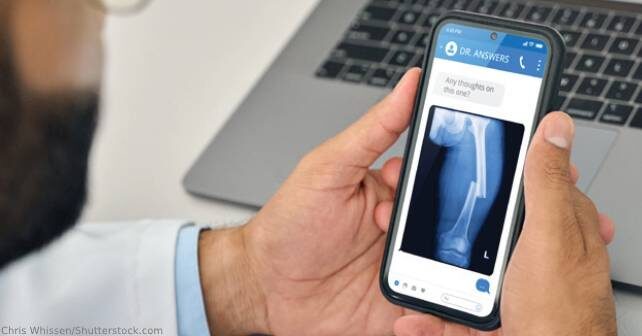
Case
A 69-year-old man presents from the assisted living facility with hip pain following a fall. He has a history of dementia and is oriented to name only. Radiographs show a left mid-shaft femur fracture. You call the on-call orthopedist, who asks you to text the radiographs.
Explore This Issue
ACEP Now: Vol 41 – No 10 – October 2022Question: Can you text the images to the orthopedist?
There are numerous resources for answers to clinical questions. Clinical textbooks, such as Tintinalli’s Emergency Medicine: A Comprehensive Study Guide, or Rosen’s Emergency Medicine, are valuable resources for studying and answering basic clinical questions. Search engines may provide more current information. Online review sources, such as UpToDate, are also rapidly accessible. However, administrative questions can be more challenging to answer in a timely manner.
National organizations may provide guidance for important clinical questions and may inform local policy development and implementation. For this question, let’s go to national organizations for guidance.
The American Medical Association (AMA) has an expansive online policy compendium, available for search on their Policy Finder at https://policysearch.ama-assn.org/policyfinder. To provide guidance on this specific issue, there is a policy entitled Privacy and Confidentiality H-315.978:1
The AMA policy states that where possible, informed consent should be obtained before personally identifiable health information is used for any purpose. However, in those situations where specific informed consent is not practical or possible, either (1) the information should have identifying information stripped from it or (2) an objective, publicly accountable entity must determine that patient consent is not required after weighing the risks and benefits of the proposed use. Re-identification of personal health information should only occur with patient consent or with the approval of an objective, publicly accountable entity.
The U.S. Department of Health and Human Services (HHS) provides guidance on Health Insurance Portability and Accountability Act (HIPAA) compliance.2
Does the HIPAA Privacy Rule permit a doctor, laboratory, or other health care provider to share patient health information for treatment purposes by fax, e-mail, or over the phone?
Pages: 1 2 | Single Page





No Responses to “Practical Considerations When Sharing Clinical Images for Treatment Purposes”